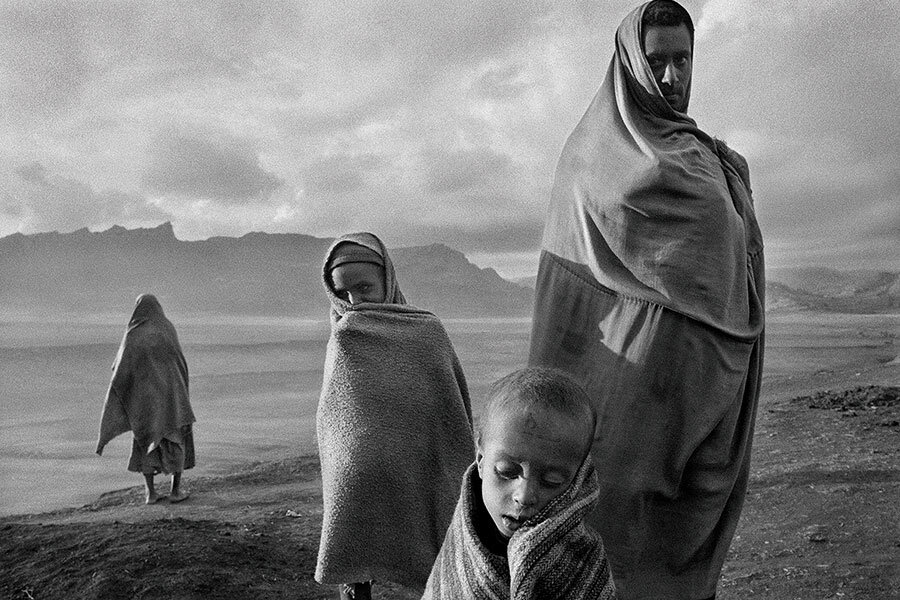'The Salt of the Earth' does justice to Sebastião Salgado's life and art
Loading...
It’s not surprising that Sebastião Salgado has had such a remarkable life. Just look at his photographs. His indelible imagery has captured some of the world’s most remote and tortuous locations. “The Salt of the Earth” – nominated for an Oscar for best documentary and codirected by Wim Wenders and Salgado’s son Juliano – does justice to his life and his art, which are all of a piece.
Juliano, who shot much of the color footage (Wenders did the remarkable black-and-white sections), is obviously attempting in this film to connect to the father whose absences spanned most of the boy’s life. Happily, the film culminates in the chronicling of their collaboration for the project “Genesis,” traveling all over the world, from Wrangel Island in Siberia to the remote highlands of Papua New Guinea.
Like Juliano, Salgado’s wife, Lélia, seems not embittered but awestruck by her husband’s almost missionary compulsion to record scenes of great anguish. She is the prime organizer of his professional life, an indispensable force. But what must it have been like for her to have him, armed only with his cameras, descend decade after decade into the world’s most troubled hot spots, including West Africa’s famine-stricken Sahel, the war-torn former Yugoslavia, and, in the wake of the first Gulf War, the burning oil fields of Kuwait? I would like to have heard more from her in the documentary.
She, too, collaborated with Salgado, and at an especially dark time in his life. For his book “Exodus,” he had photographed ravaged exiles of war, finishing up with the civil war in Rwanda, an experience so horrific he felt his “soul was sick” and mankind beyond salvation.
It was Lélia who pulled him back to health, restoring, through replanting, his father’s arid family estate in his native Brazil. The replanting techniques they devised were so successful they have been used to reforest vast swatches of Brazil’s Mata Atlântica. It was this rejuvenation that inspired the “Genesis” project with Juliano.
Salgado started out, of all things, as an economist for the World Bank. Moving to Paris in the 1960s as a self-exile from Brazil’s dictatorship, he became, with Lélia’s encouragement, a professional photographer, making his mark in the “Workers” series from the 1980s with the famous images of thousands of Brazilian workers toiling in the giant open-pit gold mine of Serra Pelada. In “The Salt of the Earth,” Salgado compares the crush of laborers scaling the mine’s vast walls to the slaves who built the pyramids – except, as he wryly notes, these men “were only slaves to the idea of becoming rich.” (He also says, in a line that sounds right out of “The Treasure of the Sierra Madre,” that “men who come in contact with gold can never leave it.”)
Throughout the documentary the filmmakers offer up an extensive array of Salgado’s work, sometimes superimposed over shots of his own face. The eerie confluence points up the intensely intimate relationship between the artist and his art.
It’s an art that has sometimes come under fire, although “The Salt of the Earth” doesn’t really acknowledge the criticism. In an influential 1991 New Yorker essay, Ingrid Sischy wrote of his photographs: “[T]his beautification of tragedy results in pictures that ultimately reinforce our passivity toward the experience they reveal. To aestheticize is the fastest way to anesthetize the feeling of those who are witnessing it. Beauty is a call to admiration, not to action.”
But this argument implies that a beautifully composed image must, almost by definition, betray the pain of its subject. It also assumes that art is only beneficial if it is a call to social action. But anybody looking at these photographs without ideological blinders can see that Salgado’s aestheticism, which is anything but anesthetic, is deeply infused with a sense of woe and outrage.
Would his photographs be more “authentic” if they were badly composed? Would Picasso’s “Guernica” or Michelangelo’s “Pietà” have profited from sloppier technique? In attempting to use Salgado’s compositional mastery against him, Sischy exposed her own aesthetic prejudices, which are weirdly anti-art. Most of the photographs on view in “The Salt of the Earth” bear witness to great suffering, and what they exalt is not the photographer’s eye but the fearful humanity that binds us all. Grade: A- (Rated PG-13 for thematic material involving disturbing images of violence and human suffering, and for nudity.)





